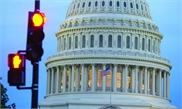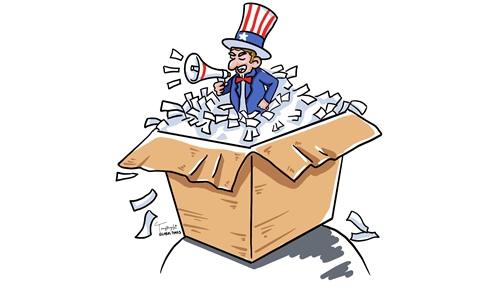
US Federal Reserve headquarters in Washington DC Photo: Xinhua
It is no secret that the US national debt is on an unsustainable path, but the question is how far it is from a real debt crisis. The US Congressional Budget Office (CBO) said on Wednesday that federal debt held by the public was projected to reach or surpass the size of the US GDP in the fiscal year that begins on October 1.Moreover, according to the CBO, US debt-to-GDP ratio has already reached its highest level since World War II, at 98 percent in 2020, media reports said. This is a disturbing development, especially considering that the US economy remains fragile and needs further fiscal support that may deteriorate its debt burden.
Over the past months, the US government tried to bail out the hard-hit families and small and medium-sized businesses through rounds of massive financial rescue programs amid fears of recession triggered by the coronavirus pandemic. And given the fact that the virus spread hasn't been effectively contained in the country, continuous stimulus support will still be essential to prevent the US economy from collapsing in the time to come.
Inevitably, generous fiscal stimulus will lead to a fast increase in federal debt and fiscal deficit. Some might optimistically expect that urgency brought by all these debt and deficit issues will naturally disappear post-pandemic as the economy will rebound and government expenditures will go down. But it should be pointed out that the US has had a debt problem for a long time.
It is deemed unsustainable for debt to grow faster than the GDP. Looking back to the eurozone sovereign debt crisis, eurozone countries tried to cope with economic slowdown through fiscal stimulus, with debt levels surging fast in countries like Greece. To a certain extent, the rapid rise in government leverage was the major trigger for the European debt crisis.
Now the US economy has been moving on a similar course and its government appears in no hurry to reverse the trend. If the US continues to use the low interest rates to issue new debts to cover its old liabilities, once the Fed raises interest rates again, all the accumulated debt bubbles may burst, causing a debt crisis that may be unprecedented in its scale.
Of course, the US has a unique financial advantage that others don't have, that is, its dollar hegemony. As the dollar is the world's dominant clearing and reserve currency, the Fed can unleash a flood of liquidity to relieve its debt pressure in some extreme scenarios, leaving the whole world to shoulder the consequences of a dollar depreciation.
Yet, there is a limit to everything. If the US government doesn't improve its balance of payments, its financial hegemony will backfire sooner or later once its debt problem explodes. And a US debt crisis, if breaks out, will send shockwaves through global markets, and the world needs to be prepared for the risks.



